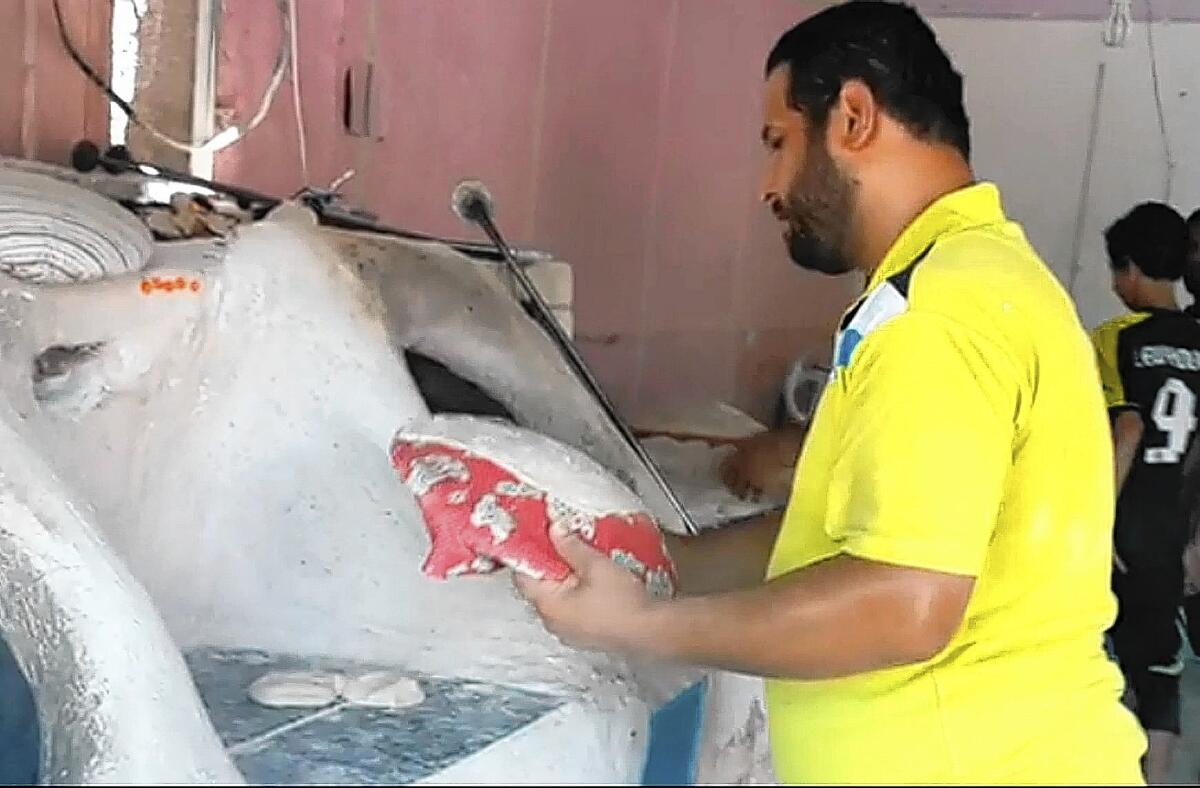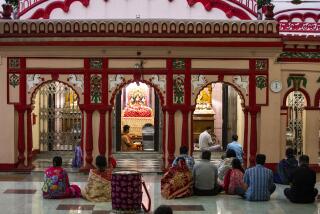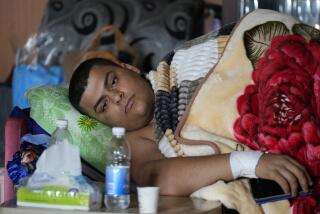Iraq militantsâ advance casts shadow over Baghdad neighborhood

Reporting from Baghdad â From his barbershop, Dhai Rahmeh recalled the dark days of 2006-07, when sectarian death squads stalked the streets, forcing thousands to flee his neighborhood, Ghazaliya. The once-sleepy residential district was soon transformed into one of the Iraqi capitalâs most notorious kill zones, a mostly no-go area even for U.S. troops, who entered with armored vehicles from heavily fortified bases.
âThere were bodies dumped every day in the streets, people were afraid to leave their homes,â said Rahmeh, 27, smoking a cigarette as he sat in one of the barber chairs in his cramped salon. âCar bombs. Assassinations. Kidnappings. It was unlivable.â
The onslaught caused the long-mixed district in northwest Baghdad to split into largely Sunni Arab and Shiite Muslim sections separated by concrete barriers, a battered vestige of the U.S. occupation. The pattern of sectarian division was repeated throughout the capital, contributing to an uneasy peace but segregating communities that once lived together in some semblance of harmony.
Today, the specter of large-scale communal bloodletting once again casts a menacing shadow: Al Qaeda-style Sunni militants who view Shiites as infidels have made sweeping territorial gains to the north and west and vowed to descend on the capital and the Shiite heartland to the south. In Baghdad and elsewhere, Shiite volunteers have been enlisting en masse to confront the threat.
Already, several car bombings and targeted killings have raised alarms.
Rumors abound in Baghdad of Sunni âsleeper cellsâ ready to strike at Shiite civilians, Shiite shrines and the Shiite-dominated government and armed forces. Retaliation from the Shiite side would be inevitable and difficult to rein in.
Many worry about the prospect of a deliberate provocation, such as the 2006 bombing of a revered Shiite shrine in the city of Samarra that detonated the conflict of 2006-07.
Such fears are plainly evident here in Ghazaliya, a sprawling working-class district of perhaps 100,000. A popular home for military officers during the rule of Saddam Hussein, Ghazaliya is one of the areas in the capital most vulnerable to any resurgence in communal killing â as well as a potential gateway into Baghdad for Sunni militants based to the west in Anbar province.
During the 2006-07 violence, Al Qaeda Sunni operatives and Mahdi Army Shiite militiamen specialized in retaliatory killings. Being nabbed at a checkpoint operated by paramilitaries of the opposite sect could mean a hasty death sentence.
A recent visit to the district, and interviews with both Shiite and Sunni residents, indicates that Ghazaliya remains calm for now.
Along Mushajjar Street (Street of the Trees), the rough dividing line between Ghazaliyaâs Shiite and Sunni districts, Jasim Saleh crafts circular pieces of fresh bread from his gas-fired oven at the Fig and Olive bakery, serving customers from all sects. He exudes confidence that the neighborhood will not again turn on itself.
âPeople donât want to go back to those days,â said Saleh, a father of five, as he took a break from placing mounds of dough along the internal wall of the oven, which soon transformed them into circles of crisp, slightly charred bread. âRight now I would say things are normal.â
Here, normal still means a separation of Shiites and Sunnis who once lived together. During the violence of 2006-07, many sold their houses on one side of the Street of the Trees to be with their co-religionists on the other end. Shiites far outnumber Sunnis here, as they do throughout Baghdad.
âPeople just feel more comfortable living with their own,â said Saleh, a Shiite.
Many of those who fled have since returned.
âThis place was a hell back then,â said Ahmad Ghazi, 22, a Sunni who escaped to Syria during the worst of the violence but now runs a small grocery shop on the Sunni side of the Street of the Trees. âItâs quiet here now, but Iraq is a mess. Itâs hard to believe in the system.â
Still, neighborhoods such as Ghazaliya demonstrate how difficult it would be to divide Iraq strictly along sectarian lines. Although Shiites are the major group in Baghdad and the south, there are many large Sunni communities in the Baghdad area and in southern Iraq as well.
In Ghazaliya, the Shiite and Sunni districts feature similar houses of one and two stories, most in the ubiquitous beige tone here. Only the many posters of Shiite clerics, âmartyrs,â and stylized images of Imam Hussein, a grandson of Islamâs founder and a revered Shiite figure, differentiate the northern and southern sections of Ghazaliya. The sectarian separation has become institutionalized.
âWhich part of Ghazaliya are you looking for?â asks a police officer at one of the checkpoints found at all entrances to the neighborhood. âShiite or Sunni?â
Concrete barriers and sand-filled canvas and mesh-wire sacks from the U.S. occupation still serve their original defensive purposes. Occasional police cars cruise the streets, but there was no sign early this week of a military presence.
Some Shiite militiamen have been seen making their presence known on the main drag in the Sunni area, one resident said, but so far have been content with a menacing show of force.
In a pointed gesture, Baghdadâs mayor, a Shiite, attended prayers recently at a Sunni mosque in Ghazaliya, delivering a message of Muslim solidarity and support for the Iraqi state.
âThat the mayor came here was very important,â said Safaa Nasser, a Sunni businessman in Ghazaliya who says he counts among his friends some of the few remaining Shiite families on the Sunni side of the Street of the Trees. âWe all suffered so much here.â
No one in Ghazaliya seems to want a reprise of the bad days. The death squads remain quiescent. No one doubts that the killers have the weapons, and recruits, to rule the streets anew. Whether forces beyond residentsâ control will bring them back remains to be seen.
Special correspondent Nabih Bulos contributed to this report.
More to Read
Sign up for Essential California
The most important California stories and recommendations in your inbox every morning.
You may occasionally receive promotional content from the Los Angeles Times.










